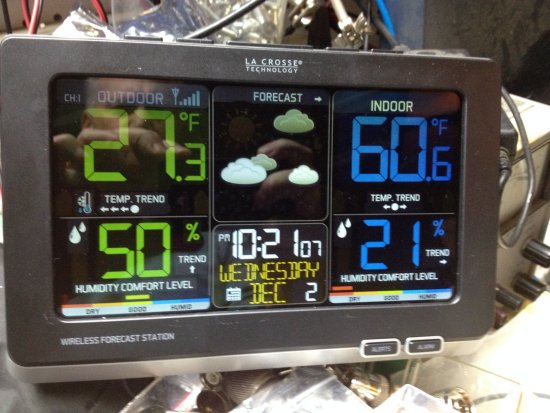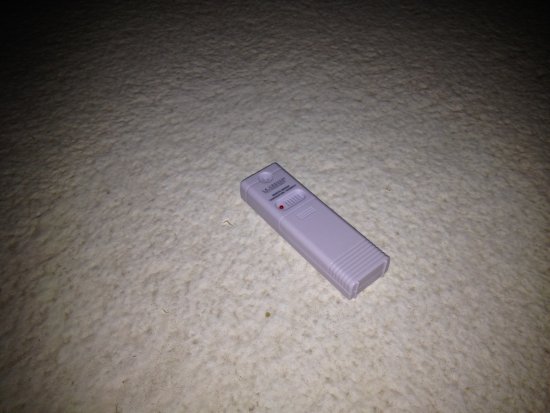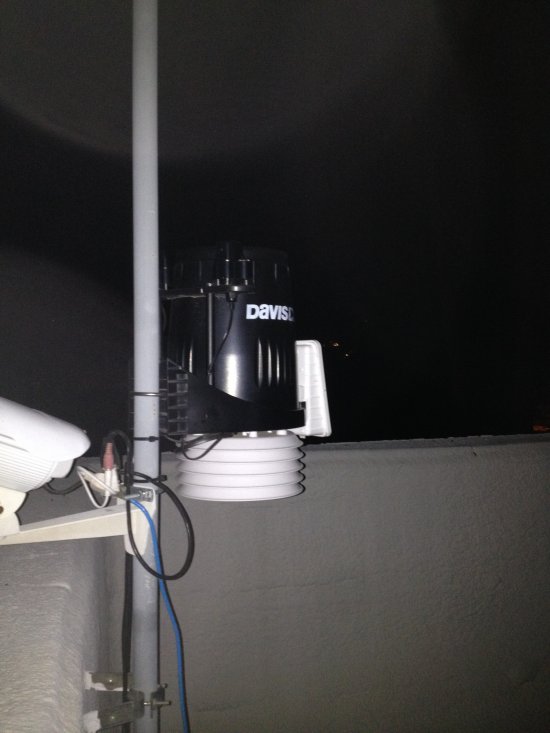Ok, it took forever to get the blog running again, but today I’m playing with temperature and the dark sky. I don’t have a lick of math to back anything up (yet), but here’s what I’m seeing.
I have a cheap weather station (from Costco) .
This wx station comes with an “outdoor” temperature sensor.
I also have a near dead-flat white foamed roof on the house (seen in the background of the sensor above). I remember a long time ago one of my great mentors Bart telling me about the ability to use the cold of deep space to freeze water outside even when the air temperature is above freezing.
I’m here in the desert, and it’s fairly dry atmosphere. The ambient air temperature (as measured by the Davis wx station about 8 m away and 2 m higher)
is 47F (281K) right now, and the sensor sitting on the roof is showing 27.3F (270K). So 11K colder. Early this morning, when the outside air temp was 272K, the roof top sensor was showing about 264K. Hard freeze temperature. If I put a pan of water on the roof next to the sensor, it will be a disc of ice in the morning. Pretty neat!
So, how’s this work? I suspect that the hemisphere of sky that the sensor is exposed to above is pretty cold, significantly more than the 3K of the CMB but not anywhere near ambient air temperature. There’s a few palm trees that stick up into that hemisphere, but that’s a small portion of the overall scene, and palm trees probably don’t have a lot of heat contribution, though they do reflect the ground, which is currently over 273K. Since the atmosphere is fairly empty, there’s not a lot of heat energy between the roof and space – it’s a clear night. That lack of heat means that there’s probably not a lot of energy to illuminate my temperature sensor laying flat on the roof. So, for that hemisphere (at least), the heat energy available is pretty low.
Now on to the other hemisphere, the one below the sensor laying flat on the roof. Well, it’s all white foam and provides a pretty good insulation from the heat of the house and the ground and shrubberies, etc., nearby. The foam under the white coating is a closed cell yellow foam and probably has pretty poor heat conduction. Given that the foam also is low density, it probably doesn’t have much heat capacity so there’s not much contribution of heat energy from that lower hemisphere, and I imagine it cools rather quickly once the sun goes down.
So, here I’m measuring the temperature at the air layer about 1 cm above the roof, and well below the parapet wall around the roof at about 20 cm. It’s dead still tonight, so there’s little air mixing at the roof level. The Davis wx station uses their usual baffled temperature sensor and is pretty close to the other temperatures measured locally, though I suspect it’s biased a bit by being so close to the roof, and not on a nice piece of open land as per NOAA/NWS siting guidelines. I’ve got a homeowners’ association to deal with, doncha know…
Anyway, I will try to get some calculations going and see what I should be able to see. If I get very ambitious, I might even build a temperature sensor “tower” that can measure the temperature at a number of distances off the roof (from touching the roof to maybe 100 cm) and see what the gradient looks like.
This also explains why the truck windshield gets frost on it some night but not others. The windshield will chill due to seeing mostly the cold sky, and it will chill faster than the ambient air when there’s little air movement. If the temperature on the surface of the windshield gets below the dew point, then I should see water ice plate out on the windshield. This happened a few nights ago, and the ice was pretty resistant to defrosting.


